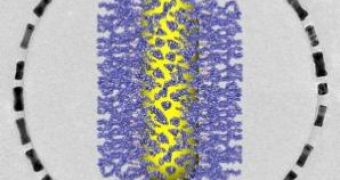Tiny gold atomic arrangements called nanorods were found to be able to spontaneously assemble themselves into ring-like superstructures by a team at Rice University.
Nanorods have dimensions of billionths of a meter (1,000 times less than a hair width).
The nanorings could boost the development of new nanotechnologies such as highly sensitive optical sensors, superlenses, and even invisible objects for military use. "Finding new ways to assemble nano-objects into superstructures is an important task because at the nanoscale, the properties of those objects depend on the arrangement of individual building blocks," said principal investigator Eugene Zubarev, the Norman Hackerman-Welch Young Investigator and assistant professor of chemistry at Rice.
Ring-like assemblies have been also found in spherical nanoparticles and other symmetrical molecules, but this is the first research to detect such structures made up by rod-shaped nanostructures.
The team employed hybrid nanorods as they present on their surface thousands of organic molecules (flexible chainlike structures).
Zubarev's team put the nanorods in a solution of chloroform (an organic solvent). When the chloroform evaporated, its surface temperature decreased enough to cause the condensation of water vapors from the air, forming dew-like droplets. The thousands of water microdroplets pressed the nanorods from the solution up against them, making the nanorods build rings around them.
The polymer cover impeded the rods from being absorbed into the droplets as they were water insoluble. When the water droplets evaporated, the nanorings remained stable. "When nanorods are organized into a ring, significant changes in their optical and electromagnetic properties occur. These can have technological applications in the area of metamaterials, which have enormous potential in opto-electronics, communications and military applications", said Zubarev.
The new technique can produce thousands of well-defined rings in a matter of seconds. "This method is surprisingly simple and can be used for organizing nanocrystals of various shapes, size and chemical composition into circular arrays."

 14 DAY TRIAL //
14 DAY TRIAL //